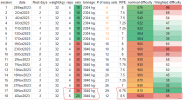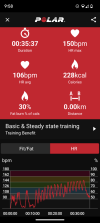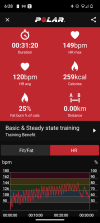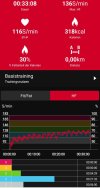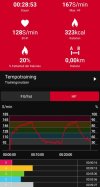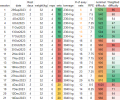You are using an out of date browser. It may not display this or other websites correctly.
You should upgrade or use an alternative browser.
You should upgrade or use an alternative browser.
Kettlebell AXE Training Thread
- Thread starter Aziatik
- Start date
Aziatik
Level 6 Valued Member
Week 6 Session 1
Crossover symmetry shoulder and glute activation then -
AXE Snatches 4s otm 28kg
22 repeats 88 reps
Rest
C&3P L /C&3P R
5 sets 30 reps total
28kg Snatches revs my system more than 40 kg swings... Was crunched for time and hence I took a 28 from my studio and carried it with me in the evening. Training in the evening feels way different than 9 or 10 am.
Feels like really my perfect swing weight is 36 kg but they're hard to come by down here in Puerto Vallarta Mexico. Brought the 28 outside today to my son's soccer practice at sunset. Life is good. Forgot to stop the polar app after the work was done...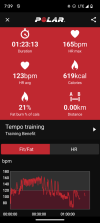
Crossover symmetry shoulder and glute activation then -
AXE Snatches 4s otm 28kg
22 repeats 88 reps
Rest
C&3P L /C&3P R
5 sets 30 reps total
28kg Snatches revs my system more than 40 kg swings... Was crunched for time and hence I took a 28 from my studio and carried it with me in the evening. Training in the evening feels way different than 9 or 10 am.
Feels like really my perfect swing weight is 36 kg but they're hard to come by down here in Puerto Vallarta Mexico. Brought the 28 outside today to my son's soccer practice at sunset. Life is good. Forgot to stop the polar app after the work was done...

Last edited:
Hey gang. Lots to think about here, and there are always many variables. Here are some thoughts:
1) Climbing has a lot of pulling. It's hard to train a lot of pulling, then go climbing & expect to have a good climbing session. When rock/ice climbing is the goal, I usually focus on a balance in my training by putting a larger emphasis on pushing, and keeping pulling to a minimum (GTG/Easy Strength). When hiking/running/Obstacle course racing are the goals go ahead and pull often. This is why it's important to cycle your training. Always have an in-season, post-season, off-season, and pre-season mentality. Choose activities that allow rest for the next activity.
So, off-season & pre-season climbing, I might snatch a lot, deadlift, clean, swing, and work on my pull-up strength GTG style. In-season and post-season I might work on my jerks, push-ups, med-ball slams, pistols, box jumps etc.
With doing AXE often, I always take the first day of the week to a stop sign. I literally have 0 amount of time or rounds in my head. When my body says stop, I stop. I've slightly modified my stop signs to: 1) loss of power as judged by speed of movement, total time to complete reps, or WATTS if on a rower/ski erg. 2) Inability to pass a talk test OR maintain a 1:1 breath:rep ratio 3) HR hits high zone 4/low zone 5 during working sets or does not recover to zone 2 during rest periods 4) RPE >7. When some sessions go long, you might ask, "well, why not go heavier?" Answer: going heavier causes weight gain (for me), which isn't ideal in the climbing world at a body weight of 88kg+
The next day, I do 40% less time than the previous day. The next day I will do 20% less time than Day 1. Rest days are definitely helpful in this model. If you wanted less rest days, keeping time duration low and alternating movements (snatch/jerk) are not bad ideas.
In sticking to a "by the book only" mentality, I'm reminded of a Star Wars quote, "Only the Sith believe in absolutes." Everyone is different, so follow the "by the book" approach until you learn what's best for you, then add your slight modifications based on what you've learned about yourself.
Hope you find these thoughts valuable in the quest to find the best way to train yourself.
1) Climbing has a lot of pulling. It's hard to train a lot of pulling, then go climbing & expect to have a good climbing session. When rock/ice climbing is the goal, I usually focus on a balance in my training by putting a larger emphasis on pushing, and keeping pulling to a minimum (GTG/Easy Strength). When hiking/running/Obstacle course racing are the goals go ahead and pull often. This is why it's important to cycle your training. Always have an in-season, post-season, off-season, and pre-season mentality. Choose activities that allow rest for the next activity.
So, off-season & pre-season climbing, I might snatch a lot, deadlift, clean, swing, and work on my pull-up strength GTG style. In-season and post-season I might work on my jerks, push-ups, med-ball slams, pistols, box jumps etc.
With doing AXE often, I always take the first day of the week to a stop sign. I literally have 0 amount of time or rounds in my head. When my body says stop, I stop. I've slightly modified my stop signs to: 1) loss of power as judged by speed of movement, total time to complete reps, or WATTS if on a rower/ski erg. 2) Inability to pass a talk test OR maintain a 1:1 breath:rep ratio 3) HR hits high zone 4/low zone 5 during working sets or does not recover to zone 2 during rest periods 4) RPE >7. When some sessions go long, you might ask, "well, why not go heavier?" Answer: going heavier causes weight gain (for me), which isn't ideal in the climbing world at a body weight of 88kg+
The next day, I do 40% less time than the previous day. The next day I will do 20% less time than Day 1. Rest days are definitely helpful in this model. If you wanted less rest days, keeping time duration low and alternating movements (snatch/jerk) are not bad ideas.
In sticking to a "by the book only" mentality, I'm reminded of a Star Wars quote, "Only the Sith believe in absolutes." Everyone is different, so follow the "by the book" approach until you learn what's best for you, then add your slight modifications based on what you've learned about yourself.
Hope you find these thoughts valuable in the quest to find the best way to train yourself.
Aziatik
Level 6 Valued Member
Good stuff here thanks for sharing! Especially as regards to HR, your manner of using it to mind the stop signs has reinforced my understanding. Cheers and happy training!Hey gang. Lots to think about here, and there are always many variables. Here are some thoughts:
1) Climbing has a lot of pulling. It's hard to train a lot of pulling, then go climbing & expect to have a good climbing session. When rock/ice climbing is the goal, I usually focus on a balance in my training by putting a larger emphasis on pushing, and keeping pulling to a minimum (GTG/Easy Strength). When hiking/running/Obstacle course racing are the goals go ahead and pull often. This is why it's important to cycle your training. Always have an in-season, post-season, off-season, and pre-season mentality. Choose activities that allow rest for the next activity.
So, off-season & pre-season climbing, I might snatch a lot, deadlift, clean, swing, and work on my pull-up strength GTG style. In-season and post-season I might work on my jerks, push-ups, med-ball slams, pistols, box jumps etc.
With doing AXE often, I always take the first day of the week to a stop sign. I literally have 0 amount of time or rounds in my head. When my body says stop, I stop. I've slightly modified my stop signs to: 1) loss of power as judged by speed of movement, total time to complete reps, or WATTS if on a rower/ski erg. 2) Inability to pass a talk test OR maintain a 1:1 breath:rep ratio 3) HR hits high zone 4/low zone 5 during working sets or does not recover to zone 2 during rest periods 4) RPE >7. When some sessions go long, you might ask, "well, why not go heavier?" Answer: going heavier causes weight gain (for me), which isn't ideal in the climbing world at a body weight of 88kg+
The next day, I do 40% less time than the previous day. The next day I will do 20% less time than Day 1. Rest days are definitely helpful in this model. If you wanted less rest days, keeping time duration low and alternating movements (snatch/jerk) are not bad ideas.
In sticking to a "by the book only" mentality, I'm reminded of a Star Wars quote, "Only the Sith believe in absolutes." Everyone is different, so follow the "by the book" approach until you learn what's best for you, then add your slight modifications based on what you've learned about yourself.
Hope you find these thoughts valuable in the quest to find the best way to train yourself.
Adachi
Level 7 Valued Member
Today felt a little easier than last time. But this week was so busy I did miss a day of getups.
Not sure how much that effects my sense of RPE.
The challenge at this point seems to live in the "Heart/lungs" side of the equation.
In which case I wonder whether this step load will be a little shorter or not.
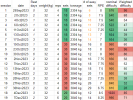
Not sure how much that effects my sense of RPE.
The challenge at this point seems to live in the "Heart/lungs" side of the equation.
In which case I wonder whether this step load will be a little shorter or not.

dP1
Level 1 Valued Member
Derek,Hey gang. Lots to think about here, and there are always many variables. Here are some thoughts:
1) Climbing has a lot of pulling. It's hard to train a lot of pulling, then go climbing & expect to have a good climbing session. When rock/ice climbing is the goal, I usually focus on a balance in my training by putting a larger emphasis on pushing, and keeping pulling to a minimum (GTG/Easy Strength). When hiking/running/Obstacle course racing are the goals go ahead and pull often. This is why it's important to cycle your training. Always have an in-season, post-season, off-season, and pre-season mentality. Choose activities that allow rest for the next activity.
So, off-season & pre-season climbing, I might snatch a lot, deadlift, clean, swing, and work on my pull-up strength GTG style. In-season and post-season I might work on my jerks, push-ups, med-ball slams, pistols, box jumps etc.
With doing AXE often, I always take the first day of the week to a stop sign. I literally have 0 amount of time or rounds in my head. When my body says stop, I stop. I've slightly modified my stop signs to: 1) loss of power as judged by speed of movement, total time to complete reps, or WATTS if on a rower/ski erg. 2) Inability to pass a talk test OR maintain a 1:1 breath:rep ratio 3) HR hits high zone 4/low zone 5 during working sets or does not recover to zone 2 during rest periods 4) RPE >7. When some sessions go long, you might ask, "well, why not go heavier?" Answer: going heavier causes weight gain (for me), which isn't ideal in the climbing world at a body weight of 88kg+
The next day, I do 40% less time than the previous day. The next day I will do 20% less time than Day 1. Rest days are definitely helpful in this model. If you wanted less rest days, keeping time duration low and alternating movements (snatch/jerk) are not bad ideas.
In sticking to a "by the book only" mentality, I'm reminded of a Star Wars quote, "Only the Sith believe in absolutes." Everyone is different, so follow the "by the book" approach until you learn what's best for you, then add your slight modifications based on what you've learned about yourself.
Hope you find these thoughts valuable in the quest to find the best way to train yourself.
I am working to complete Sinister…I am 50 yrs old and ~180 lbs. My best time with the Beast so far is 21 minutes. I recently completed your Speed Metal course which was awesome. So I recently started incorporating snatches to AXE in hopes of building to finish Sinister. This week I did an AXE snatch workout 5 reps alternating arms for 40 rounds with 24kg KB on Tuesday, rested Wednesday and then a Q&D 10/2 for 4 rounds w/40kg KB yesterday, and today an AXE 40 rounds with the Beast. Going to take 2 days off then do a Timeless S&S with the Beast but try to complete such to break 20 minutes and work to start the getups with the minute rest and shoot for 45 seconds between reps. Any suggestions on how to best use AXE and Q&D with snatches and swings to enable me to keep lowering my S&S times? Getting to Timeless Sinister has definitely transferred over to being able to jump right into high volume and heavy AXE training. Hoping the change in A+A type training helps me get over the finish line. Looking forward to any suggestions anyone has I should consider in programming my training. I completed my first Timeless Sinister on 31 December last year in 42 minutes. It took this long to flirt with breaking 20 minutes. Was hoping to complete by Dec 31st this year but am realizing that may not be realistic. I can finish the swings in 5 minutes But am too gassed to start the getups a minute later and sustain on the minute reps…Thanks for your time and consideration. I am so glad I found StrongFirst a year and a half ago. Never dreamed I’d become this functionally fit at my age!
Bauer
Level 8 Valued Member
The last month has been a bit rough: Work related stress, co-workers and family members having colds, inflammation of a tooth, to name a few.
Therefore, I did not feel that well. I did some deloads (60-80% of volume), but otherwise just stayed at my current step (20 minutes) for 5 weeks. RPE did not really drop that much (although on most sessions, I felt kind of fatigued from the beginning, and it actually did not get any worse over time). Usually, I would have counted this as a plateau, but not this time around, given the circumstances.
Anyway, yesterday I finally felt better and just went until I met the stop signs: 32 minutes (after staying at 20 minutes for 5 weeks).
This goes to show that this type of "autoregulated step loading" works really well, even when life happens. I just trusted the process and stayed patient, actually getting better through cold season than most of the people around me while still building the base for progress.
Therefore, I did not feel that well. I did some deloads (60-80% of volume), but otherwise just stayed at my current step (20 minutes) for 5 weeks. RPE did not really drop that much (although on most sessions, I felt kind of fatigued from the beginning, and it actually did not get any worse over time). Usually, I would have counted this as a plateau, but not this time around, given the circumstances.
Anyway, yesterday I finally felt better and just went until I met the stop signs: 32 minutes (after staying at 20 minutes for 5 weeks).
This goes to show that this type of "autoregulated step loading" works really well, even when life happens. I just trusted the process and stayed patient, actually getting better through cold season than most of the people around me while still building the base for progress.
Red_and_Black
Level 6 Valued Member
Finished my 4th week of 3 x AXE sessions a week today. I started at 4 x OTM 1H swings @ 28kg for 30 mins and yesterday completed 60 minutes for a total of 240 swings (total weight is 6,720kg).
Doing this for 4 more weeks (3 weekly sessions again plus my standard 2 x 7.5km Z2 runs commuting to work with Sun and Mon as rest days) and starting with a 32kg x 4 OTM tomorrow at 40 mins which is 160 swings (total weight is 5,120kg but in less time obviously).
Will build up again (assuming no stop signs) to 60 minutes over 2 weeks (I aim to add 4 minutes each session) and then swap to 6 x OTM 1H swings (dropping back to 40 mins to build back to 60) if all feels good along the way for the last 2 weeks.
I did 8 weeks of strength training before this which really took it out of me and I ended up with some shoulder and elbow niggles which have slowly recovered doing just AXE and some running. I enjoy the AXE sessions and finish them feeling refreshed and energetic rather than beaten up! It's hard to quantify progress apart from the length of sessions, but everything physical feels easier, especially my runs home.
After this 4 weeks I have a 3 week break (holiday away) and will change my training program when I get back, but I think I will keep one long AXE session weekly for some level of maintenance.
Doing this for 4 more weeks (3 weekly sessions again plus my standard 2 x 7.5km Z2 runs commuting to work with Sun and Mon as rest days) and starting with a 32kg x 4 OTM tomorrow at 40 mins which is 160 swings (total weight is 5,120kg but in less time obviously).
Will build up again (assuming no stop signs) to 60 minutes over 2 weeks (I aim to add 4 minutes each session) and then swap to 6 x OTM 1H swings (dropping back to 40 mins to build back to 60) if all feels good along the way for the last 2 weeks.
I did 8 weeks of strength training before this which really took it out of me and I ended up with some shoulder and elbow niggles which have slowly recovered doing just AXE and some running. I enjoy the AXE sessions and finish them feeling refreshed and energetic rather than beaten up! It's hard to quantify progress apart from the length of sessions, but everything physical feels easier, especially my runs home.
After this 4 weeks I have a 3 week break (holiday away) and will change my training program when I get back, but I think I will keep one long AXE session weekly for some level of maintenance.
Last edited:
dP1
Level 1 Valued Member
AXE Training is amazing. I love the simplicity and change of pace. Over the last couple of months I have been incorporating AXE to hopefully help me get over a plateau in my Sinister quest. I've been stuck at around 22 minutes for a while now being too gassed after the swings to be able to complete my getups with only a minute rest. Last week I did 3 workouts, A snatch AXE session with 24kg for 40 rounds, a Q&D 40kg swings 10/2 for four rounds, rested 2 days and then did an AXE with the Beast normal swings 6 reps starting on the minute for 40 rounds. I took 2 days off and today I did a Sinister session with the goal of 16 seconds for each set of 10 1-arm swings then 25 seconds of rest in between for the 10 sets then taking a 1 minute 35 seconds rest before starting the get ups allowing 30 seconds for each getup and 45 seconds rest between. The last time I tried this I had to stop at 8 on the getups because I was too gassed to safely continue. Today I am thrilled my AXE sessions seem to really be paying off. I finally broke the 20 minute barrier completing the Sinister in 19:45, a 1 minute 54 second improvement on my former personal best. I actually felt I had several more getups in the bank so very happy I was able to finish strong. Here's my updated plan:
Monday: Sinister, taking 1 second off my former rest times for each set which should decrease my overall time by 18-20 seconds. I plan to keep the 1 minute and 30 seconds of rest between the swings and getups until I whittle down to 5 minutes total for the swings and 10 minutes for the getups then will decrease until I feel comfortable at the minute rest between. So I have 3:45 to shave off to hit the 16 minute mark. (Really thinking the AXE and Q&D mix and only doing Sinister once a week on Mondays pushing for a gradual decrease in time might be the answer I'm looking for.)
Tuesday: Q&D snatches 24kg using the dice method for sets/reps
Wednesday: Active walking playing golf 6-7 miles pushing my clubs on the push cart
Thursday: AXE with 32-40kg switching hands for 6 reps starting on the minute for 30-40 rounds depending on how I feel utilizing the STOP signs
Friday: AXE w/Beast normal swings 6 reps on the minute for 30-40 rounds again utilizing the STOP signs
Saturday and Sunday: Active rest
I train in my garage in Colorado Springs, CO at an elevation of 6800 feet. Wondering if I were to attempt Sinister at Sea Level how much better I might be able to do...thinking altitude can definitely have a huge affect on performance.
I would like to encourage anyone who needs a change of pace to start using the AXE protocol right away. A Definite Game Changer in my opinion!
Monday: Sinister, taking 1 second off my former rest times for each set which should decrease my overall time by 18-20 seconds. I plan to keep the 1 minute and 30 seconds of rest between the swings and getups until I whittle down to 5 minutes total for the swings and 10 minutes for the getups then will decrease until I feel comfortable at the minute rest between. So I have 3:45 to shave off to hit the 16 minute mark. (Really thinking the AXE and Q&D mix and only doing Sinister once a week on Mondays pushing for a gradual decrease in time might be the answer I'm looking for.)
Tuesday: Q&D snatches 24kg using the dice method for sets/reps
Wednesday: Active walking playing golf 6-7 miles pushing my clubs on the push cart
Thursday: AXE with 32-40kg switching hands for 6 reps starting on the minute for 30-40 rounds depending on how I feel utilizing the STOP signs
Friday: AXE w/Beast normal swings 6 reps on the minute for 30-40 rounds again utilizing the STOP signs
Saturday and Sunday: Active rest
I train in my garage in Colorado Springs, CO at an elevation of 6800 feet. Wondering if I were to attempt Sinister at Sea Level how much better I might be able to do...thinking altitude can definitely have a huge affect on performance.
I would like to encourage anyone who needs a change of pace to start using the AXE protocol right away. A Definite Game Changer in my opinion!
dP1
Level 1 Valued Member
Got My Goal! Finished in 19:45....personal best by 1:54. Finished swings in 6:25, 1:35 rest then started the getups. 45 sec rest after each. Getups taking 11:45 sec...AXE definitely helping break the plateau...will decrease my rest by 1-sec next time for each so 24 seconds rest for getups, 2 seconds less in between 1:33 and rest 44 sec between the getups. That should be a 20 second improvement. Hopefully that will whittle my time down over the next 8 weeks to flirt with completing the Sinister quest!Derek,
I am working to complete Sinister…I am 50 yrs old and ~180 lbs. My best time with the Beast so far is 21 minutes. I recently completed your Speed Metal course which was awesome. So I recently started incorporating snatches to AXE in hopes of building to finish Sinister. This week I did an AXE snatch workout 5 reps alternating arms for 40 rounds with 24kg KB on Tuesday, rested Wednesday and then a Q&D 10/2 for 4 rounds w/40kg KB yesterday, and today an AXE 40 rounds with the Beast. Going to take 2 days off then do a Timeless S&S with the Beast but try to complete such to break 20 minutes and work to start the getups with the minute rest and shoot for 45 seconds between reps. Any suggestions on how to best use AXE and Q&D with snatches and swings to enable me to keep lowering my S&S times? Getting to Timeless Sinister has definitely transferred over to being able to jump right into high volume and heavy AXE training. Hoping the change in A+A type training helps me get over the finish line. Looking forward to any suggestions anyone has I should consider in programming my training. I completed my first Timeless Sinister on 31 December last year in 42 minutes. It took this long to flirt with breaking 20 minutes. Was hoping to complete by Dec 31st this year but am realizing that may not be realistic. I can finish the swings in 5 minutes But am too gassed to start the getups a minute later and sustain on the minute reps…Thanks for your time and consideration. I am so glad I found StrongFirst a year and a half ago. Never dreamed I’d become this functionally fit at my age!
Jacobcutt
Level 5 Valued Member
I recently stepped up from the 32kg to the 40kg bell. It's a pretty decent weight at 53% body weight.
Two reps each minute was easy on the cardio and respiratory systems, and only took three sessions to adjust to. I finished my first session with four reps on the minute last night. I stopped at 28 minutes with the skin on my hands being the limiting factor. My heart rate never exceeded 130 bpm.
I will do a few more sessions with four reps OTM, ensuring form is excellent throughout. I am starting to feel the 40kg float on the hand switches. It's good to feel such a (relatively) heavy weight float in front of me. I look forward to working into six reps on the minute.
I do not want to buy a bigger bell. Once I achieve good form with six reps on the minute out to thirty minutes, I will start to extend the sessions to forty minutes. Not sure where I will go from there.
In the back of my mind is perhaps really starting to work on the snatch. Once I achieve the above, I may drop down weight and work on perfecting snatch technique, with the long-term goal of doing A&A sessions with snatches.
Two reps each minute was easy on the cardio and respiratory systems, and only took three sessions to adjust to. I finished my first session with four reps on the minute last night. I stopped at 28 minutes with the skin on my hands being the limiting factor. My heart rate never exceeded 130 bpm.
I will do a few more sessions with four reps OTM, ensuring form is excellent throughout. I am starting to feel the 40kg float on the hand switches. It's good to feel such a (relatively) heavy weight float in front of me. I look forward to working into six reps on the minute.
I do not want to buy a bigger bell. Once I achieve good form with six reps on the minute out to thirty minutes, I will start to extend the sessions to forty minutes. Not sure where I will go from there.
In the back of my mind is perhaps really starting to work on the snatch. Once I achieve the above, I may drop down weight and work on perfecting snatch technique, with the long-term goal of doing A&A sessions with snatches.
Bauer
Level 8 Valued Member
By "easy sets", do you mark the moment when it gets hard?The descending RPE is pretty steady here, even though I've interrupted my training schedule with a Test Day for max Reps.
View attachment 23451
This program currently feels like I could run it forever.
I will be returning to this protocol many times in the future.
I ask because usually the first few sets don't feel that easy to me, and "easy sets" usually start happening after 5-10 minues.
Adachi
Level 7 Valued Member
Yeah, something like that.By "easy sets", do you mark the moment when it gets hard?
I guess the number of easy sets is interchangeable for the number of sets that are "not-hard sets" . Where, to one degree or another , I don't feel like I'm digging in, to get them done.
There are a few things that I start noticing later in the session.
- Imperfect recovery between sets
- While my breath is still recovering between sets, my heart rate is nominally elevated.
- Using my will-power to enforce the bell coming up to shoulder height
- I am not pleasantly hurrying back to the bell for the next set.
- The breathing immediately after the set is nominally heavier.
Interestingly, I'm not currently experiencing a a decrease in RPE at the outset. I speculate that timing my session in the afternoon when I feel more energetic. if I was practicing in the morning, I'd probably benefit hugely from a warmup.I ask because usually the first few sets don't feel that easy to me, and "easy sets" usually start happening after 5-10 minues.
I am sympathetic to the description of "junk volume", here; at least on a surface level. The first several sets don't quite register on the scale of perceived difficulty.
I joked to myself one day, ...
"these sets don't even do anything ...
maybe I should skip them."
maybe I should skip them."
Some underload, it would seem, to me, has other value. Those initial reps, where all the details of the rep seems to be more completely under my control allows for very productive moments of sensing contraction and practicing the enforcement of the desired form. The snap into the plank and the enforcement of low back lordosis at the bottom of the hike back come to mind.
But, yes I'm counting the sets till "the turn". Whenever it is that the going gets tough. And, I suppose that if I was having some warm up sets at the beginning of the set where I was warming up to the session, I would omit those from that metric.
Bauer
Level 8 Valued Member
I like this list a lot. The will-power point is an interesting one. This is usually the point where I really start to focus on recovery, fast-and-loose, and technique.There are a few things that I start noticing later in the session.
- Imperfect recovery between sets
- While my breath is still recovering between sets, my heart rate is nominally elevated.
- Using my will-power to enforce the bell coming up to shoulder height
- I am not pleasantly hurrying back to the bell for the next set.
- The breathing immediately after the set is nominally heavier.
mar2safety
Level 6 Valued Member
Just started AXE 1HS this week, in earnest. Because I plan on running this for several months, I conservatively used the 28k.
Tuesday - 28k 1HS, 4 reps per repeat, 20 repeats, RPE 6, no stop signs
Friday - repeated the same Tuesday session, RPE 5, no stop signs
This next week, I'm planning on 30 repeats, as long as stop signs not hit, same volume Tues and Fri. Prior to AXE coming out, I would periodically snatch 4 reps, top of every minute, switching hands every set, in an A&A type session.
Tuesday - 28k 1HS, 4 reps per repeat, 20 repeats, RPE 6, no stop signs
Friday - repeated the same Tuesday session, RPE 5, no stop signs
This next week, I'm planning on 30 repeats, as long as stop signs not hit, same volume Tues and Fri. Prior to AXE coming out, I would periodically snatch 4 reps, top of every minute, switching hands every set, in an A&A type session.

